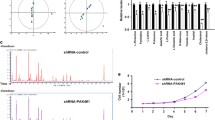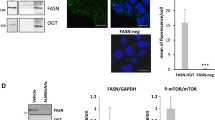Abstract
Insulin-like growth factor-1 (IGF-1) plays the role in cellular lipid synthesis and cell proliferation. However, the role of IGF-1 on the growth of colon cancer cell line HCT-8 is not clear. In this study, HCT-8 cells were exposed to IGF-1 at 0, 10, 50, or 100 ng/ml in serum-free medium. Fatty acid/lipid synthesis in HCT-8 cells was examined by 2-14C-acetate incorporation. HCT-8 cell growth and proliferation were determined by MTT assay and Trypan blue exclusive viable cell counting. We found that in serum starvation conditions, IGF-1 at 10–100 ng/ml induced dose-dependent down regulation of both the ACCα expression and the phosphorylation in HCT-8 cells, maintaining a balance in ACCα activity and lipid synthesis. IGF-1 reduced p-ATM, p-AMPK, and then p-ACCα protein levels in HCT-8 cells. IGF-1 increased p-Akt levels, but decreased p-ERK1/2 levels, leading to the decrease in ACCα protein and mRNA levels. Similarly, ERK1/2 inhibitor PD98059 reduced ACCα expression. IGF-1 influences neither HCT-8 cell growth nor their p53 protein levels and PARP cleavage. In a word, IGF-1 reduced ACCα phosphorylation via an ATM/AMPK signaling pathway and suppressed ACCα expression through an ERK1/2 transduction, playing a dual role in regulating ACCα activity and lipogenesis. This may render a cell with survival advantages under a serum starvation crisis, representing a novel mitogenic role of IGF-1.





Similar content being viewed by others
Abbreviations
- ACCα:
-
Acetyl-CoA carboxylase-α
- AMPK:
-
AMP-activated protein kinase
- ATM:
-
Ataxia telangiectasia mutated
- ERK1/2:
-
Extracellular signal-regulated kinase 1/2
- IGF-1:
-
Insulin-like growth factor-1
- PI3K:
-
Phosphoinositide-3-kinase
References
Oldham S, Hafen E (2003) Insulin/IGF and target of rapamycin signaling: a TOR de force in growth control. Trends Cell Biol 13:79–85
Glass DJ (2003) Molecular mechanisms modulating muscle mass. Trends Mol Med 9:344–350
Wang F, Ijuin T, Itoh T, Takenawa T (2011) Regulation of IGF-1/PI3K/Akt signaling by the phosphoinositide phosphatase pharbin. J Biochem. doi:10.1093/jb/mvr037
Tang Y, Zhang W, Tang H, Li P (2011) Protective effects of IGF-1 on neurons under condition of hypoxia and the role of PI3K signal pathway. Zhong Nan Da Xue Xue Bao Yi Xue Ban 36:21–6
Chapuis N, Tamburini J, Cornillet-Lefebvre P, Gillot L, Bardet V, Willems L, Park S, Green AS, Ifrah N, Dreyfus F, Mayeux P, Lacombe C, Bouscary D (2010) Autocrine IGF-1/IGF-1R signaling is responsible for constitutive PI3K/Akt activation in acute myeloid leukemia: therapeutic value of neutralizing anti-IGF-1R antibody. Haematologica 95:415–423
Ma J, Sawai H, Matsuo Y, Ochi N, Yasuda A, Takahashi H, Wakasugi T, Funahashi H, Sato M, Takeyama H (2010) IGF-1 mediates PTEN suppression and enhances cell invasion and proliferation via activation of the IGF-1/PI3K/Akt signaling pathway in pancreatic cancer cells. J Surg Res 160:90–101
Bibollet-Bahena O, Almazan G (2009) IGF-1-stimulated protein synthesis in oligodendrocyte progenitors requires PI3K/mTOR/Akt and MEK/ERK pathways. J Neurochem 109:1440–1451
Smith TM, Gilliland K, Clawson GA, Thiboutot D (2008) IGF-1 induces SREBP-1 expression and lipogenesis in SEB-1 sebocytes via activation of the phosphoinositide 3-kinase/Akt pathway. J Invest Dermatol 128:1286–1293
Ferre P, Foufelle F (2010) Hepatic steatosis: a role for de novo lipogenesis and the transcription factor SREBP-1c. Diabetes Obes Metab 12(Suppl 2):83–92
Kim YM, Shin HT, Seo YH, Byun HO, Yoon SH, Lee IK, Hyun DH, Chung HY, Yoon G (2010) Sterol regulatory element-binding protein (SREBP)-1-mediated lipogenesis is involved in cell senescence. J Biol Chem 285:29069–29077
Tarling E, Salter A, Bennett A (2004) Transcriptional regulation of human SREBP-1c (sterol-regulatory-element-binding protein-1c): a key regulator of lipogenesis. Biochem Soc Trans 32:107–109
Choi YS, Cho HY, Hoyt KR, Naegele JR, Obrietan K (2008) IGF-1 receptor-mediated ERK/MAPK signaling couples status epilepticus to progenitor cell proliferation in the subgranular layer of the dentate gyrus. Glia 56:791–800
Modica S, Morgano A, Salvatore L, Petruzzelli M, Vanier MT, Valanzano R, Esposito DL, Palasciano G, Duluc I, Freund JN, Mariani-Costantini R, Moschetta A (2009) Expression and localisation of insulin receptor substrate 2 in normal intestine and colorectal tumours. Regulation by intestine-specific transcription factor CDX2. Gut 58:1250–1259
Harwood HJ Jr, Petras SF, Shelly LD, Zaccaro LM, Perry DA, Makowski MR, Hargrove DM, Martin KA, Tracey WR, Chapman JG, Magee WP, Dalvie DK, Soliman VF, Martin WH, Mularski CJ, Eisenbeis SA (2003) Isozyme-nonselective N-substituted bipiperidylcarboxamide acetyl-CoA carboxylase inhibitors reduce tissue malonyl-CoA concentrations, inhibit fatty acid synthesis, and increase fatty acid oxidation in cultured cells and in experimental animals. J Biol Chem 278:37099–37111
Kim KH (1997) Regulation of mammalian acetyl-coenzyme A carboxylase. Annu Rev Nutr 17:77–99
Harwood HJ Jr (2005) Treating the metabolic syndrome: acetyl-CoA carboxylase inhibition. Expert Opin Ther Targets 9:267–281
Tong L (2005) Acetyl-coenzyme A carboxylase: crucial metabolic enzyme and attractive target for drug discovery. Cell Mol Life Sci 62:1784–1803
Ganguly J (1960) Studies on the mechanism of fatty acid synthesis. VII. Biosynthesis of fatty acids from malonyl CoA. Biochim Biophys Acta 40:110–118
Goldman P, Alberts AW, Vagelos PR (1961) Requirement for a malonyl CoA-CO2 exchange reaction in long chain but not short chain fatty acid synthesis in Clostridium Kluvveri. Biochem Biophys Res Commun 5:280–285
Seubert W, Lamberts I, Kramer R, Ohly B (1968) On the mechanism of malonyl-CoA-independent fatty acid synthesis. I. The mechanism of elongation of long-chain fatty acids by acetyl-CoA. Biochim Biophys Acta 164:498–517
Ventura FV, Costa CG, IJ L, Dorland L, Duran M, Jakobs C, de Almeida IT, Wanders RJ (1997) Broad specificity of carnitine palmitoyltransferase II towards long-chain acyl-CoA beta-oxidation intermediates and its practical approach to the synthesis of various long-chain acylcarnitines. J Inherit Metab Dis 20:423–426
Jensen MD (2002) Fatty acid oxidation in human skeletal muscle. J Clin Invest 110:1607–1609
Chen J, Jeppesen PB, Nordentoft I, Hermansen K (2007) Stevioside improves pancreatic beta-cell function during glucotoxicity via regulation of acetyl-CoA carboxylase. Am J Physiol Endocrinol Metab 292:E1906–E1916
Zhang S, Kim KH (1998) Essential role of acetyl-CoA carboxylase in the glucose-induced insulin secretion in a pancreatic beta-cell line. Cell Signal 10:35–42
Kemp BE, Stapleton D, Campbell DJ, Chen ZP, Murthy S, Walter M, Gupta A, Adams JJ, Katsis F, van Denderen B, Jennings IG, Iseli T, Michell BJ, Witters LA (2003) AMP-activated protein kinase, super metabolic regulator. Biochem Soc Trans 31:162–168
Hardie DG (2008) AMPK a key regulator of energy balance in the single cell and the whole organism. Int J Obes 32(Suppl 4):S7–S12
Hardie DG (2008) Role of AMP-activated protein kinase in the metabolic syndrome and in heart disease. FEBS Lett 582:81–89
Woods A, Dickerson K, Heath R, Hong SP, Momcilovic M, Johnstone SR, Carlson M, Carling D (2005) Ca2+/calmodulin-dependent protein kinase kinase-beta acts upstream of AMP-activated protein kinase in mammalian cells. Cell Metab 2:21–33
Ma J, Yan R, Zu X, Cheng JM, Rao K, Liao DF, Cao D (2008) Aldo-keto reductase family 1 B10 affects fatty acid synthesis by regulating the stability of acetyl-CoA carboxylase-alpha in breast cancer cells. J Biol Chem 283:3418–3423
Zhao LF, Iwasaki Y, Zhe W, Nishiyama M, Taguchi T, Tsugita M, Kambayashi M, Hashimoto K, Terada Y (2010) Hormonal regulation of acetyl-CoA carboxylase isoenzyme gene transcription. Endocr J 57:317–324
Makaula S, Adam T, Essop MF (2006) Upstream stimulatory factor 1 transactivates the human gene promoter of the cardiac isoform of acetyl-CoA carboxylase. Arch Biochem Biophys 446:91–100
Park SH, Gammon SR, Knippers JD, Paulsen SR, Rubink DS, Winder WW (2002) Phosphorylation-activity relationships of AMPK and acetyl-CoA carboxylase in muscle. J Appl Physiol 92:2475–2482
Thampy GK, Haas MJ, Mooradian AD (2000) Troglitazone stimulates acetyl-CoA carboxylase activity through a post-translational mechanism. Life Sci 68:699–708
Haystead TA, Hardie DG (1988) Insulin and phorbol ester stimulate phosphorylation of acetyl-CoA carboxylase at similar sites in isolated adipocytes. Lack of correspondence with sites phosphorylated on the purified enzyme by protein kinase C. Eur J Biochem 175:339–345
Pellatt LJ, Rice S, Mason HD (2011) Phosphorylation and activation of amp-activated protein kinase (ampk) by metformin in the human ovary requires insulin. Endocrinology 152(3):1112–1118
Witters LA, Watts TD, Daniels DL, Evans JL (1988) Insulin stimulates the dephosphorylation and activation of acetyl-CoA carboxylase. Proc Natl Acad Sci USA 85:5473–5477
Fu X, Wan S, Lyu YL, Liu LF, Qi H (2008) Etoposide induces ATM-dependent mitochondrial biogenesis through AMPK activation. PLoS One 3:e2009
Sun Y, Connors KE, Yang DQ (2007) AICAR induces phosphorylation of AMPK in an ATM-dependent, LKB1-independent manner. Mol Cell Biochem 306:239–245
Suzuki A, Kusakai G, Kishimoto A, Shimojo Y, Ogura T, Lavin MF, Esumi H (2004) IGF-1 phosphorylates AMPK-alpha subunit in ATM-dependent and LKB1-independent manner. Biochem Biophys Res Commun 324:986–992
Fuentes EN, Bjornsson BT, Valdes JA, Einarsdottir IE, Lorca B, Alvarez M, Molina A (2011) The IGF-I/PI3K/Akt and the IGF-I/MAPK/ERK pathways in vivo in skeletal muscle are regulated by nutrition and contribute to somatic growth in the fine flounder. Am J Physiol Regul Integr Comp Physiol. doi:10.1152/ajpregu.00535.2010
Hixon ML, Paccagnella L, Millham R, Perez-Olle R, Gualberto A (2010) Development of inhibitors of the IGF-IR/PI3K/Akt/mTOR pathway. Rev Recent Clin Trials 5:189–208
Unni E, Koul D, Yung WK, Sinha R (2005) Se-methylselenocysteine inhibits phosphatidylinositol 3-kinase activity of mouse mammary epithelial tumor cells in vitro. Breast Cancer Res 7:R699–R707
Shen Y, White E (2001) P53-dependent apoptosis pathways. Adv Cancer Res 82:55–84
Turinetto V, Porcedda P, Minieri V, Orlando L, Lantelme E, Accomasso L, Amoroso A, De Marchi M, Zannini L, Delia D, Giachino C (2010) A novel defect in mitochondrial p53 accumulation following DNA damage confers apoptosis resistance in Ataxia Telangiectasia and Nijmegen Breakage Syndrome T-cells. DNA Repair 9:1200–1208
Milyavsky M, Gan OI, Trottier M, Komosa M, Tabach O, Notta F, Lechman E, Hermans KG, Eppert K, Konovalova Z, Ornatsky O, Domany E, Meyn MS, Dick JE (2010) A distinctive DNA damage response in human hematopoietic stem cells reveals an apoptosis-independent role for p53 in self-renewal. Cell Stem Cell 7:186–197
Hublarova P, Greplova K, Holcakova J, Vojtesek B, Hrstka R (2010) Switching p53-dependent growth arrest to apoptosis via the inhibition of DNA damage-activated kinases. Cell Mol Biol Lett 15:473–484
Nam C, Doi K, Nakayama H (2010) Etoposide induces G2/M arrest and apoptosis in neural progenitor cells via DNA damage and an ATM/p53-related pathway. Histol Histopathol 25:485–493
Bitomsky N, Hofmann TG (2009) Apoptosis and autophagy: Regulation of apoptosis by DNA damage signalling-roles of p53, p73 and HIPK2. FEBS J 276:6074–6083
Simbulan-Rosenthal CM, Rosenthal DS, Iyer S, Boulares AH, Smulson ME (1998) Transient polyation (ADP-ribosyl) of nuclear proteins and role of poly (ADP-ribose) polymerase in the early stages of apoptosis. J Biol Chem 273:13703–13712
Boulares AH, Yakovlev AG, Ivanova V, Stoica BA, Wang G, Iyer S, Smulson M (1999) Role of poly (ADP-ribose) polymerase (PARP) cleavage in apoptosis. Caspase 3-resistant PARP mutant increases rates of apoptosis in transfected cells. J Biol Chem 274:22932–22940
Tosca L, Chabrolle C, Crochet S, Tesseraud S, Dupont J (2008) IGF-1 receptor signaling pathways and effects of AMPK activation on IGF-1-induced progesterone secretion in hen granulosa cells. Domest Anim Endocrinol 34:204–216
Treins C, Murdaca J, Van Obberghen E, Giorgetti-Peraldi S (2006) AMPK activation inhibits the expression of HIF-1alpha induced by insulin and IGF-1. Biochem Biophys Res Commun 342:1197–1202
Adi S, Bin-Abbas B, Wu NY, Rosenthal SM (2002) Early stimulation and late inhibition of extracellular signal-regulated kinase 1/2 phosphorylation by IGF-I: a potential mechanism mediating the switch in IGF-I action on skeletal muscle cell differentiation. Endocrinology 143:511–516
Robey RB, Hay N (2009) Is Akt the “Warburg kinase”?-Akt-energy metabolism interactions and oncogenesis. Semin Cancer Biol 19:25–31
Author information
Authors and Affiliations
Corresponding author
Additional information
Di-Xian Luo and Xu-hong Peng contributed equally to this work.
Rights and permissions
About this article
Cite this article
Luo, DX., Peng, Xh., Xiong, Y. et al. Dual role of insulin-like growth factor-1 in acetyl-CoA carboxylase-alpha activity in human colon cancer cells HCT-8: downregulating its expression and phosphorylation. Mol Cell Biochem 357, 255–262 (2011). https://doi.org/10.1007/s11010-011-0896-0
Received:
Accepted:
Published:
Issue Date:
DOI: https://doi.org/10.1007/s11010-011-0896-0




